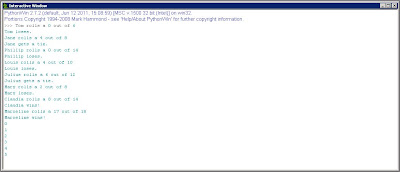Sunday, June 30, 2013
Thursday, June 27, 2013
Homeland Security: Prepare MEDS
Minimum Essential Dataset (MEDS)
This is a screenshot of the minimum essential dataset stipulated by the Department of Homeland Security for the Boston Metropolitan Statistical Area. Layer (.lyr) files store symbology and scale range settings for the each group layer. This makes distributing data easy and ensures everyone is using the same symbology.
Sunday, June 23, 2013
DC Crime Lab
Population Density with Washington D.C. Crime
This map shows the population per square mile of Washington D.C. overlaid with crime event points and police station locations. The vertical bar graph shows the number and type of crime reported during the month of January 2011.
Crime Distribution Among Police Stations
This map takes the data above one step further. I created a spatial join between the police station locations and crime event points to determine the distribution of crimes. Knowing the total number of crime incidents for Washington D.C., I was able to determine which police stations may be overwhelmed. This information can assist planners in determining a location for a new police station.
Crime Heat Maps
The Kernel Density tool was used to create three different heat maps. This information can be used to help direct law enforcement patrols with the goal of deterring future crime.
Thursday, June 20, 2013
HLS Law Enforcement: Participation Activity
In the
article, A Better Method to Smooth Crime Incident Data, crime data from the New
York City Police Department On-Line Complaint System is used to compare the
differences between methods of kernel estimation. Kernel estimation is the
spatial statistical method used to generate density maps. Police departments
use crime density maps to identify crime hotspots and plan patrol schedules, so
it is important that the map is as accurate as possible. In this week's lab we
used crime data from Washington DC to generate crime density maps and propose a
location for a new police station. The kernel estimation method used in the lab
was based on the areal extent of Washington DC. However, as this article points
out, there is a more accurate method for kernel estimating.
Kernel
smoothing estimates the variation in density of events based on a point
pattern, resulting in a map of smooth density values. Kernel estimation is
successful in making sense of complex point patterns. The most important step
in kernel estimation is selecting the bandwidth. Maps generated with a small
bandwidth are spiky in appearance, and those maps generated with a large bandwidth
appear smooth and generalized. As with either method, density maps can then be
used to create other datasets for further analysis.
Most GIS
programs base its kernel estimation on the areal extent of the event data
without considering the spatial distribution of the points. The result is large
bandwidths being selected for small sample sizes and small bandwidths for the large.
This article proposes selecting the bandwidth based on a predetermined number
of points, or neighbors, represented by the variable 'k' called the k-nearest neighbor
method. This method bases the bandwidth on the average distances between the
event data. Varying the value of 'k' allows the GIS analyst to specify the
degree of smoothing which reveals the previously unrealized variation in
density across the study area. This added capability must be used with caution
though, as the user defined input can still result in a misleading or
inaccurate map.
http://www.esri.com/news/arcuser/0199/crimedata.html
Saturday, June 15, 2013
Python Fundamentals II
Python Dice Game Result
The result of this script lists eight players with their score from the roll of a dice and whether or not they are a winner. The list of numbers at the bottom are the result of a while loop counting from zero to five.
Thursday, June 13, 2013
Hurricanes
Hurricane Sandy 2012
This map charts the track of Hurricane Sandy displaying wind speed and pressure along the way. States that made disaster declarations with FEMA are represented as well.
Hurricane Sandy 2012 Damage Assessment
This map shows pre and post storm imagery of a small section of the New Jersey shore. Structure damage points were placed over each parcel and then classified by comparing the two sets of imagery.
Wednesday, June 5, 2013
Python Fundamentals I
Successful Result
This is a screen shot of a script result that displays my last name. Then it calculates the length of my last name and displays the result multiplied by 3.
Tuesday, June 4, 2013
Japan Tsunami Lab
Fukushima Evacuation Zones
This week I created a File Geodatabase with Feature and Raster Datasets. I populated the datasets with shapefiles and DEMs of North East Japan. I also created a point feature class for Japan Cities from XY coordinate data in an Excel spreadsheet. This map was then created to show the evacuation zones in relation to the Fukushima II Nuclear Power Plant.
Subscribe to:
Comments (Atom)









